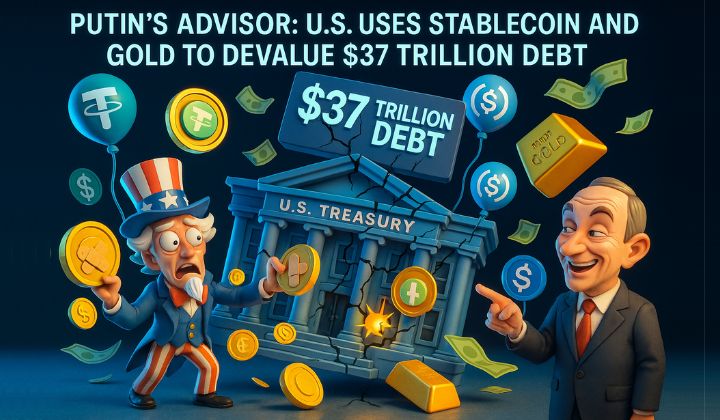The Allegation Heard Around the World
Digital currencies and geopolitical strategy have become a major focus of interest because a top Russian economic advisor made recent accusations. The advisor claims that the United States uses stablecoins and gold market manipulation to lower its massive £29 trillion national debt.
The political nature of these statements creates important questions about how financial assets will transform their position in the global macroeconomic system. The advisor suggests stablecoins function as digital dollar-backed assets which enable the United States to maintain its position as the leading market power worldwide.
The dollar’s strength receives support through alleged gold market interference which makes stablecoins more complex as potential dollar substitutes. The worldwide community faces major international consequences and economic stability risks because of these allegations which require detailed analysis of current strategies.
The US financial environment shown in the image demonstrates the essential discussion about these emerging market trends.
The Context: U.S. Debt Climbs to $37 Trillion
Current U.S. Debt Size ($37 trillion)
The $37 trillion U.S. national debt creates a massive financial burden which global economic organizations face during their struggle with unprecedent economic challenges. The debt issue remains as a key point of discussion concerning both monetary policy and fiscal sustainability.
Economists have articulated concern about the debt increase since interest rates persist to rise and budget deficits stay. The experts fear that the U.S. economic stability and its international standing will face long-term consequences.
The Washington administration reportedly considers implementing new financial tools to address its economic challenges. The international economic systems require liquidity support through cryptocurrency and gold markets according to experts.
The economic advisor to Putin made a statement that supports the U.S. potential use of stablecoins and gold price management to reduce its massive debt burden.
The implementation of these measures would create a new global financial system which would transform how nations handle their fiscal duties under heavy debt burdens.
The bar graph demonstrates the relationship between U.S. debt expansion from 2010 to 2025 and stablecoin and gold market capitalization growth which shows the critical nature of the situation.
| Category | Value |
| Total Federal Liabilities | $42.9 trillion |
| Federal Debt and Interest Payable | $26.4 trillion |
| Federal Employees’ Accrued Benefits | 33% of total liabilities |
| Additional Liabilities (Social Security and Medicare Benefits) | $36.5 trillion |
| Combined Total Liabilities and Benefits | $79.4 trillion |
| Total Liabilities as Percentage of GDP | 290.4% |
U.S. Federal Liabilities and Debt as of September 30, 2023
Putin’s Advisor’s Claim Explained
Here’s a brief mention of Putin’s advisor’s claim about U.S. debt strategy using stablecoins. The manipulation of digital assets through global economic strategies has become more prominent according to various statements made about digital assets. A Russian financial expert recently proposed that the United States employs stablecoins USDT and USDC together with its gold reserves to manage its substantial $37 trillion debt burden.
The assertion demonstrates that stablecoins function as digital dollar assets which enhance U.S. dollar influence worldwide through non-traditional monetary channels. The management of gold prices serves to support dollar stability through a dual system that controls inflation and absorbs market liquidity.
The description of stablecoins as debt-exporting instruments reveals a hidden analysis of the financial systems which support worldwide commercial operations. The political nature of this claim forces us to examine how new financial technologies could transform current national economic planning methods.
The image demonstrates this discourse through its depiction of cryptocurrency integration with traditional financial institutions in a dollar-dominant market.

Image1. Digital representation of financial markets highlighting $7 trillion value and stablecoin usage.
Stablecoins as U.S. Dollar Proxies—Strengthening Dollar Dominance
The rising adoption of stablecoins in financial operations indicates a fundamental change in how the United States can leverage its economic dominance.
Stablecoins linked to the U.S. dollar through USDT and USDC enable smooth international transactions and serve as digital currency representatives that extend American financial influence past traditional banking systems.
The digital assets with a combined market value exceeding $160 billion maintain dollar liquidity while keeping inflation under control. The U.S. achieves digital seigniorage through stablecoin integration into decentralized markets because this unique advantage allows it to benefit from worldwide usage without facing typical currency supply growth consequences.
The dollar strengthening strategy through stablecoin management aligns with Putin’s advisor who claims the U.S. uses stablecoins and gold to control its $37 trillion debt while maintaining its position as a global leader. [cited]
| Date | Tether (USDT) Market Capitalization (USD billions) | USD Coin (USDC) Market Capitalization (USD billions) | Binance USD (BUSD) Market Capitalization (USD billions) | Dai (DAI) Market Capitalization (USD billions) | TerraUSD (UST) Market Capitalization (USD billions) | Other Stablecoins Market Capitalization (USD billions) | Total Stablecoin Market Capitalization (USD billions) | Percentage of Stablecoins Pegged to USD |
| 2020-12-31 | 20.94 | 3.93 | 0.99 | 1.17 | 0.18 | 1.09 | 28.3 | 99 |
| 2021-01-01 | 21.17 | 4.12 | 1.08 | 1.21 | 0.18 | 1.13 | 28.89 | 99 |
| 2021-01-02 | 21.27 | 4.14 | 1.15 | 1.19 | 0.18 | 1.17 | 29.1 | 99 |
| 2021-01-03 | 21.37 | 4.21 | 1.17 | 1.25 | 0.18 | 1.15 | 29.33 | 99 |
| 2021-01-04 | 21.8 | 4.17 | 1.03 | 1.32 | 0.18 | 1.14 | 28.64 | 99 |
Stablecoin Market Capitalization and U.S. Dollar Dominance
Advisor’s claim: U.S. Allegedly Manipulates Stablecoins and Gold to Manage/Offset Debt Pressures
Vladimir Putin’s Senior Advisor Anton Kobyakov stated that the United States uses stablecoins and cryptocurrencies together with gold to handle its $35 trillion national debt. The GENIUS Act which Congress passed in July 2025 controls stablecoin operations while establishing rules for approved stablecoin issuers.
Key Points
Kobyakov proposed that the United States could trigger a stablecoin market failure to decrease its debt burden through Treasury bond purchases at lower prices.
The stablecoin market led by Tether and USDC holds more US Treasury bonds than Saudi Arabia does as reserves because these stablecoins are backed by the US dollar. The stablecoin Tether maintains $127 billion worth of assets in its reserves.
Stablecoins support US debt financing according to some experts yet Kobyakov and other critics view them as instruments for market manipulation.
The stablecoin market value of $285 billion remains far below the $35 trillion total amount of US national debt. Stablecoin failures in the market would not reduce debt levels substantially unless they triggered widespread market instability.
The value of gold tends to rise when investors become concerned about US debt levels because gold functions as a protective asset during times of economic instability. [Link1]
Michael Saylor has publicly suggested that the United States could sell some or all of its gold reserves and instead invest in Bitcoin. Michael Saylor has made a public statement that the United States should exchange its gold reserves for Bitcoin to demonstrate its financial leadership.
The worldwide effects of such an action would create substantial and extensive changes for all nations that compete with the United States. Saylor believes this move would decrease the value of assets owned by Russia and China thus compelling them to use Bitcoin and redirect their capital toward the United States.
Global economic and geopolitical impacts
- Gold market collapse: The United States maintains the world’s biggest gold reserves which amount to 8,133 metric tons. A massive gold reserve sale from the United States would create a market surplus that would drive gold prices down dramatically.
The value of gold would plummet to zero for rival nations that possess substantial gold reserves including Russia and China thus damaging their national financial stability and currency value.
The traditional function of gold as an inflation and geopolitical risk protection asset has existed for centuries. The U.S. decision to sell its gold reserves would destroy the established safe-haven status of gold which would create worldwide financial instability for investors and central banks. - Bitcoin market surge and financial shift: The U.S. government acquiring a substantial amount of Bitcoin would trigger an extreme price increase in the cryptocurrency. The cryptocurrency would experience increased price swings because of this move which would draw more speculative investors into the market.
The U.S. would receive substantial capital inflows because Saylor predicts that nations which lost money from the gold devaluation would need to acquire Bitcoin to recover their funds and join the new reserve asset system. The U.S. financial dominance would become more established because of this capital influx.
The official U.S. backing of Bitcoin would establish its global legitimacy which would speed up its adoption by international governments and business organizations. The worldwide financial structure would undergo a complete transformation.
Responses from rival countries
- Opposing nations would probably interpret this economic move as hostile so they would start diversifying their reserves into different assets while speeding up their Central Bank Digital Currency (CBDC) development. The rivals would purchase Bitcoin to recover their losses but they would also work on developing multiple assets to decrease their dependence on U.S. financial systems.
- The strategic change would create increased competition between financial and geopolitical forces. The U.S. would use its Bitcoin assets and former gold reserves to start a new form of economic warfare according to certain experts who predict this conflict will emerge as a reserve asset struggle.
- The first phase of this power struggle would bring financial losses to rival nations who would face disadvantages, but their long-term actions would decide the outcome of the reserve asset competition.
Challenges and risks
- The value of Bitcoin remains unpredictable because it lacks the stability of gold which has proven itself as a valuable asset throughout thousands of years. The U.S. economy would face uncharted risks because of Bitcoin price fluctuations when it adopts this digital currency.
- The majority of central banks maintain their preference for gold reserves as reserve assets so they would probably fight against any efforts to decrease its value.
- The United States would face new security threats because of its dependence on Bitcoin as a digital reserve system which includes risks to network stability and control systems and cyber-attacks.
The theoretical proposal of Michael Saylor for financial dominance through Bitcoin reserve adoption would create a high-risk situation for the United States. The United States would gain control over rival nations through a gold-to-Bitcoin reserve transition which would create short-term financial damage to its competitors.
The United States would face major market instability and worldwide financial system transformation while facing severe international political consequences from such a move. [Link2]
Conclusion – The Digital Geopolitics of Money
The intersection of finance and geopolitics produces an interesting story which demonstrates how monetary instruments transform global power dynamics.
The trusted Putin advisor reveals through his statement about U.S. stablecoin and gold market manipulation that the country needs to manage its massive $37 trillion debt that digital currencies are becoming essential instruments of economic control.
The U.S. dollar maintains its dominant position in the market through stablecoins USDT and USDC which function as dollar proxies to expand American financial influence into decentralized markets.
Digital assets enable smoother international transactions which help the United States control debt through liquidity management and inflation reduction.
The combination of established gold reserves with modern digital currencies establishes a new financial domain of geopolitical power where Bitcoin might evolve into the leading reserve asset of the future.
The economic struggle between nations now occurs through blockchain technology instead of traditional financial institutions according to this developing economic system.
References:
- Karen Dawisha. ‘Putin’s Kleptocracy.’ Who Owns Russia?, Simon and Schuster, 9/22/2015
- Wayne cv. Robinson. ‘America Is $37 Trillion in Debt: The Silent Crisis That Could Shatter the American Dream.’ Wayne C. Robinson, 7/18/2025
- Link1
- Link2
Image References:
- Image: Digital representation of financial markets highlighting $7 trillion value and stablecoin usage., Accessed: 2025. https://www.cryptobreaking.com/wp-content/uploads/2025/09/1757381824.png
You need to login in order to Like



















Leave a comment